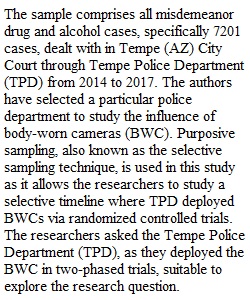


Q Assignment #1 - Identify original, empirical research, review it, and critique it! Assignment #1 will be spilt up into five small "chunks". In this chunk you only have to identify an article that fits the criteria. You will revisit this same article in Assignment #1 parts B, C, D and E! So, make sure you find the topic of the article interesting. The combination of all of these, A-E is a thorough analysis of an original research article. The parts could be combined to start you off on your way to an annotated bibliography or literature review of your own. Assignment #1D - Original Research Article - Identify and Evaluate Sample Purpose: The purpose of this assignment is to demonstrate your ability to identify and evaluate a sampling technique in social research. Skills: You will identify the sampling technique in a research study. You will evaluate the strengths and potential weaknesses in the sampling technique using the required reading and class discussions as a guide. You will demonstrate your ability to paraphrase original research. Knowledge: You will begin to gain knowledge about the topic of interest that you would like to study further - perhaps in Capstone (in a real literature review you would continue this many times over until you felt you understood the state of the topic entirely). Task: 1. Use online databases – through the library – to identify a peer-reviewed, original, empirical research article on the topic of your interest (Assignment #1A) 2. Once you have identified the article fits the criteria (peer-reviewed, original research, and is actually readable), save a pdf of the article (Assignment #1A) 3. The synopsis about sampling should be in complete sentences, 50 to 100 words, and should address all of the items noted below. 4. Upload BOTH your synopsis and the pdf of the article. 1. 1. 1. What is the sampling strategy? Whom did they ask and how did they find them? 2. What was the total sample size? 3. Is this a probability or non-probability sample? 4. What does the sample size indicate about the ability to generalize the findings? Criteria: You must address all items noted above in a coherent and well-written essay. A complete rubric is found below. Be sure to upload BOTH your synopsis and your original article. Rubric Assignment #1 - Article Critique - Sample Assignment #1 - Article Critique - Sample Criteria Ratings Pts This criterion is linked to a Learning OutcomeSampling - B level Identify sampling techniques threshold: 4.0 pts 5 pts Exceeds 4 pts Meets 3 pts Mostly meets 2 pts Some indication it meets 1 pts Does Not Meet 0 pts Ungradeable 5 pts This criterion is linked to a Learning OutcomeSampling - A level Critique a sampling technique threshold: 4.0 pts 5 pts Exceeds 4 pts Meets 3 pts Mostly meets 2 pts Some indication it meets 1 pts Does Not Meet 0 pts Ungradeable 5 pts Total Points: 10
View Related Questions